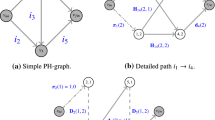Abstract
Problem solving and decision-making have a vital role to play in both technical and non-technical fields. Some decisions are simple while others require more effort and time to solve. This article introduces a new problem solving technique called Phototropic optimization algorithm, inspired from the optimised growth pattern in plants. It has been observed that the stem tips of a plant always grow towards sunlight. In this algorithm, the underlying hormonal mechanism of phototropism is emulated to solve computational problems. This phenomenon has indicated strong prospects of algorithmic efficiency and invites further research into prospective computational applications. Phototropic algorithm is developed as an optimization technique to solve real time application such as shortest path finding problems, travelling salesman problem, finding congestion in a network or any similar problem seen around. A prototype on finding the minimal distance between any two nodes in the physical network is modelled here. The asymptotic time complexity analysis shows the algorithm routes packages in O (n log n). Comparison with the traditional algorithms gives sufficient evidence for the efficiency of this proposal. This can be implemented over Software Defined Networks (SDN) for increasing system capabilities in route analytics and functionalities. Extension of this optimization algorithm is useful to solve various real time problems.













Similar content being viewed by others
References
Siddique N, Adeli H (2015) Nature inspired computing: an overview and some future directions. J Cogn Comput 7:706–714
Koepfli JB, Kenneth Thimann V, Went FW (1938) Phythohormones: structure and physiological activity. Int J Biochem 2(1):763–780
Chapin FS (1980) The mineral nutrition of wild plants. Ann Rev Ecol System 1(2):233–260
Lennart Johnson S (1984) Combining parallel and sequential traversal. Int J Parallel Process 2(2):493–499
Ettlinger C, Lehle L (1988) Auxin induces rapid changes in phosphatidylinositol metabolites. Nature 1(1):176–178
Ke H, Ma W, Ni Y (2009) Optimization models and a GA-based algorithm for stochastic time-cost trade-off problem. App Math Comput 215(1):308–313
Xiao B, et al (2007) An efficient algorithm for dynamic shortest path tree update in network routing. J Commun Network 9(4):499–510
Jiang B, Liu X (2011) Computing the fewest-turn map directions based on the connectivity of natural roads. Int J Geogr Inf Sci 25(7):1069–1082
Xing T, Zhou X (2013) Reformulation and solution algorithms for absolute and percentile robust shortest path problems. IEEE Trans Intell Transport Syst 14(2):943–954
Vinod Chandra SS (2016) Smell detection agent based optimization algorithm. J Instit Eng (India) Series B 97(3):431–436
Ananthalakshmi Ammal R, Sajimon PC, Vinod Chandra SS (2017) Application of smell detection agent based algorithm for optimal path identification by SDN controllers. Lect Notes Comput Sci 10386:502–510
Zhang M, Yang M, Wu Q, Zheng R, Zhu J (2018) Smart perception and autonomic optimization: a novel bio-inspired hybrid routing protocol for MANETs. Futur Gener Comput Syst 81:505–513
Saritha R, Vinod Chandra SS (2019) Multimodal foraging by honey bees toward optimizing profits at multiple colonies. IEEE Intell Syst 34(1):14–22
Fahim H, Li W, Javaid S, Sadiq Fareed MM, Ahmed G, Khattak MK (2019) Fuzzy logic and bio-inspired firefly algorithm based routing scheme in intrabody nanonetworks. Sensors, 19
Abdel-Basset M, Shawky LA (2019) Flower pollination algorithm: a comprehensive review. Artif Intell Rev 52:2533–57
Bhattacharjee KK, Sarmah SP (2014) Shuffled frog leaping algorithm and its application to 0/1 knapsack problem. Appl Soft Comput 19:252–263
Liu L, Song Y, Zhang H, Ma H, Vasilakos AV (2015) Physarum optimization: a biology-inspired algorithm for the steiner tree problem in networks. IEEE Trans Comput 64(3):818–831
Ammal RA, Sajimon PC, Vinod Chandra SS (2020) Termite inspired algorithm for traffic engineering in hybrid software defined networks. PeerJ Comput Sci 6:1–21
Ananthalakshmi Ammal R, Sajimon PC, Vinod Chandra SS (2020) Canine algorithm for node disjoint paths. Lect Notes Comput Sci 12145:142–148
Liu YK (2007) The independence of fuzzy variables with applications to fuzzy random optimization. Int J Uncertain Fuzziness Knowl Based Syst 15(2):1–20
Yao J, Lin F (2003) Fuzzy shortest-path network problems with uncertain edge weights. J Inf Sci Eng 19(2):329–351
Acknowledgments
Authors would like to thank Government of India for acknowledging the efforts on developing the phototropic algorithm and thereby providing us with the Copyright of the proposed work (Registration No. L 74114/2018, Dated.28-03-2018). We also would like to extend thanks to the Machine Intelligent Research Group and to Centre for Development of Advanced Computing, Government of India for the help they have extended during the various phases of study and implementation.
Author information
Authors and Affiliations
Corresponding author
Additional information
Publisher’s note
Springer Nature remains neutral with regard to jurisdictional claims in published maps and institutional affiliations.
Rights and permissions
About this article
Cite this article
Chandra S. S., V., Hareendran S., A. Phototropic algorithm for global optimisation problems. Appl Intell 51, 5965–5977 (2021). https://doi.org/10.1007/s10489-020-02105-4
Accepted:
Published:
Issue Date:
DOI: https://doi.org/10.1007/s10489-020-02105-4




